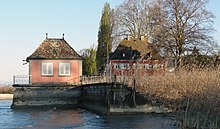Güttingen (noble family)
The barons of Güttingen were a Thurgau noble family from the 12th to 14th centuries with the castles Kachel and Moosburg near Güttingen , in the vicinity of which their possessions were concentrated.
history
Although the Güttingen are well documented, the identification of individual representatives and their genealogical classification is difficult, not least because they mainly had the first names Rudolf, Ulrich and Heinrich and many of them were clergy . However, various people with the name Güttingen were not related to this family.
The Güttingen is documented for the first time with the canon Ulrich, who appeared in 1159 as a witness for the Bishop of Constance , in whose environment she appeared again and again later. Their home monastery was Salem , which they donated and where various representatives found their final resting place. Representatives of the family were repeatedly called in to serve in the Reich ; Rudolf von Güttingen, for example, abbot of St. Gallen from 1220 and also Bishop of Chur from 1224 to 1226 , bought himself out of this obligation from Friedrich II .
Due to the political rise of the Habsburgs and the changing economic and social framework conditions, the Güttingen, like other noble families, came under increasing pressure in the second half of the 13th century. In the dispute over the Kyburg inheritance in 1264 they were just as unsuccessful with Habsburg as they were in 1285 when they tried to enforce a claim to the bailiwick over the monastery from the inheritance of the Rapperswilers through Rudolf, Abbot of Einsiedeln and last representative of the family, in an important ecclesiastical position . While one branch of the family in Constance became citizens of Constance at the end of the 13th century as von Güttingen at the tower , other representatives sought the proximity of the abbot of St. Gallen and the Werdenbergers .
Tile and Moosburg castles
The two castles with the associated rights and property came to the Barons von Enne, who immigrated from South Tyrol, after Adelheid's marriage in 1313.
The tile was a moated castle , a two-story rectangular building with a hipped roof . Bishop Johann Franz Schenk von Stauffenberg had the castle demolished between 1710 and 1725 and replaced by the newly built Güttingen Castle .
![]()
In place of the original Moosburg, there is now a classicist villa (three-storey rectangular building with a hipped roof on a raised, protruding base storey ), which was built from the stones of the former moated castle.![]()
See also
literature
- Martin Leonhard: from Güttingen. In: Historical Lexicon of Switzerland .
This article is largely based on the entry in the Historisches Lexikon der Schweiz (HLS), which, according to the HLS's usage information, is licensed under the Creative Commons - Attribution - Distribution under the same conditions 4.0 International (CC BY-SA 4.0) license . - O. Leutenegger: The barons of Güttingen and the castle as the seat of the episcopal bailiff. In: Thurgauer Jahrbuch. Volume 5, 1929. (archived in E-Periodica.ch of the ETH-Bibliothek , PDF; 10.6 MB).


